🚨 The Challenge: Late Payments Are Draining SaaS Growth
Even with strong pipelines, SaaS companies struggle to fund growth. 93% businesses lose revenue due to late payments, and 22% purely due to defaults.
The causes span every layer:
- 💸 Buyer-side: procurement delays, budget constraints, churn
- 🧾 Seller-side: manual invoicing, limited term flexibility, failed payments
- 🌐 Systemic: cross-border lags, compliance holds, multi-entity complexity
To fix this, teams turn to accounts receivable management Software to reduce Day Sales Outstanding (DSO), automate collections, and gain visibility.
But the market is flooded with options; choosing the right one is hard. And even the best solutions still make you wait to get paid.
⚡ This guide compares top accounts receivable management software—starting with Ratio Boost, the only one that eliminates AR altogether and ensures you have a smooth cash flow.
Before we get to that list, let’s look at what you, as a buyer, should consider when adopting such software.
✅ The SaaS Buyer’s Guide to Accounts Receivable Management Software
The global accounts receivable management software market is huge, projected to reach $9.4B by 2032.
Most vendors promise automation and efficiency. But beneath the buzzwords, SaaS teams still face high DSO, delayed collections, and disconnected workflows.
To cut through the noise, here’s a tiered framework for evaluating accounts receivable management software:
✅ Tier 1: Operational Efficiency (Table Stakes)
These are some foundational features every serious AR platform must have.
⚙️ Automated Invoicing & Recurring Billing
- Dynamic invoice templates by region, contract type, and tax rules
- Handles subscriptions, usage-based, milestone-based, and hybrid billing
- Multi-entity and multi-currency support with localized tax compliance
Why it matters: Reduces billing errors, enables expansion, and supports complex pricing models.
🔁 Smart Collections Automation
- Multi-channel dunning workflows (email/SMS/voice).
- Smart prioritization of follow-ups (by risk, size, aging).
- Personalized outreach templates & escalation logic.
Why it matters: Cuts DSO while preserving buyer experience.
💳 Customer-Friendly Payment Options
- Supports ACH, wires, credit cards, wallets (Apple Pay, PayPal), and international currencies
- Buyer self-service portals for AutoPay, invoice lookup, and payment tracking
- Reminders synced with due dates & account portal.
Why it matters: Reduces friction for buyers, increases the likelihood of on-time payment. Flexible terms close deals.
✅ Tier 2: Intelligence & Integration (Differentiators)
These capabilities separate modern AR platforms from legacy trackers.
⚙️ Cash Application Automation
- AI/ML auto-matching for incoming payments to invoices
- Handles short-pays, deductions, refunds, and partial payments
- Confidence scoring and suggested reconciliation actions
Why it matters: Shrinks “unapplied cash” and speeds up revenue recognition..
📊 Real-Time AR Intelligence
- Dashboards tracking DSO trends, aging buckets, and collection effectiveness
- Alerts for at-risk accounts and early churn signals
- Custom reports for bad debt vs. collected, forecasted cash vs. actual
Why it matters: Turns AR into a forecasting engine that informs budgeting, hiring, and runway planning.
🔌 Tight Integrations
- Native or API integrations with Salesforce, HubSpot, NetSuite, QuickBooks, Xero
- Syncs with Stripe, Plaid, Chargebee, and other billing/payment platforms
- Real-time, bidirectional sync to eliminate dual data entry
Why it matters: Aligns finance, sales, and customer success—so AR doesn’t become a silo or friction point.
✅ Tier 3: Growth & Governance (Scalability Enablers)
Features that future-proof your AR stack as your SaaS business grows.
👥 Role-Based Access & Collaboration
- User permissions for finance, RevOps, sales, and customer success
- Shared notes, internal threads, and audit trails on accounts
- Approval workflows for invoice edits, write-offs, and refunds
Why it matters: Enables cross-functional alignment around revenue and collections.
🌍 Scalability & Extensibility
- Supports global subsidiaries, reseller networks, and multi-tier billing
- Handles millions of invoices per month with modular pricing
- White-labeled buyer portals for a consistent brand experience
Why it matters: Ensures system longevity as GTM evolves (e.g., usage-based pricing, expansion markets).
🧠 Bonus Tier: Strategic Accelerators (Next-Gen Capabilities)
Innovations that are rapidly becoming must-haves.
⚡ Financing Built-In
- Let buyers pay on terms (net-30, net-60, milestone) while you get paid total upfront
- Embed real-time financing offers into the invoice or checkout
- Ratio Boost enables this—no repayment risk, no aging invoices, no delays
Why it matters: Transforms AR from a collection process into an instant liquidity engine for SaaS sellers.
🔮 AI Predictive Collections
- Predict which invoices are likely to go delinquent
- Recommend optimal outreach channel, time, and message
- Prioritize follow-ups, reduce write-offs, and lower AR headcount
Why it matters: Focuses human effort where it matters most, and prevents bad debt before it happens.
With these factors in mind, we have shortlisted the five best accounts receivable management software options SaaS companies use to streamline collections, improve cash flow, and reduce DSO.
Five Best Accounts Receivable Management Software Options to Choose From
Over 50% of B2B invoices in the U.S are overdue, costing businesses billions every year. Manual invoicing and reactive collections drain finance teams. New tools are tackling AR in different ways: some automate collections, while others (like Ratio Boost) eliminate AR completely.
Here are five leading AR management software options SaaS finance teams are turning to:
Let’s break them down. 👇
1) Ratio Boost (Standout Option that Eliminates AR Entirely, Still Supercharges Cash Flow)
Traditional AR tools help you manage outstanding invoices — track payments, send reminders, chase collections, and reduce DSO. But they still assume you’re not getting paid upfront. They optimize the chase, not the cash.
Ratio Boost removes the receivables layer entirely. It embeds financing at the point of quote or invoice, so:
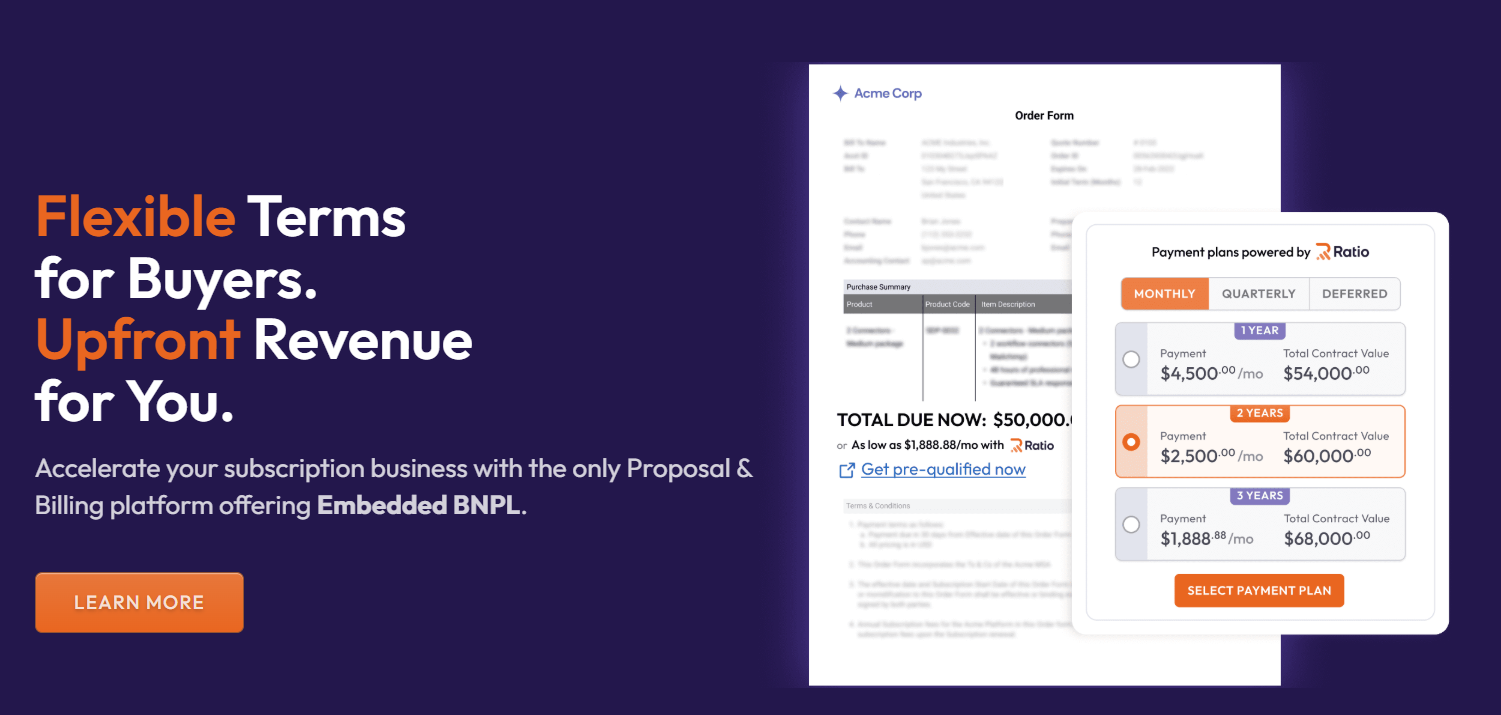
- 🧾 Buyers pay on flexible terms (net-30, milestone-based, deferred, etc.)
- 💰 You get paid full contract value upfront — by Ratio, not the buyer
- ⚖️ Ratio assumes the repayment risk — no aging AR, no dunning, no bad debt
- 🔄 You don’t need a standalone AR stack — the cash is already in your account
Instead of managing outstanding invoices, you're managing cash already collected for business growth initiatives. With Ratio Boost you don't fix a problem, you prevent it from happening in the first place.
🔑 Ratio Boost’s Core AR Management Capabilities
- 🧾 BNPL with Embedded Financing - Let buyers pay on flexible terms — net-30, net-60, or milestones — while you get full contract value upfront from Ratio. Financing is embedded at quote and checkout. No receivables. No repayment risk. No delays.
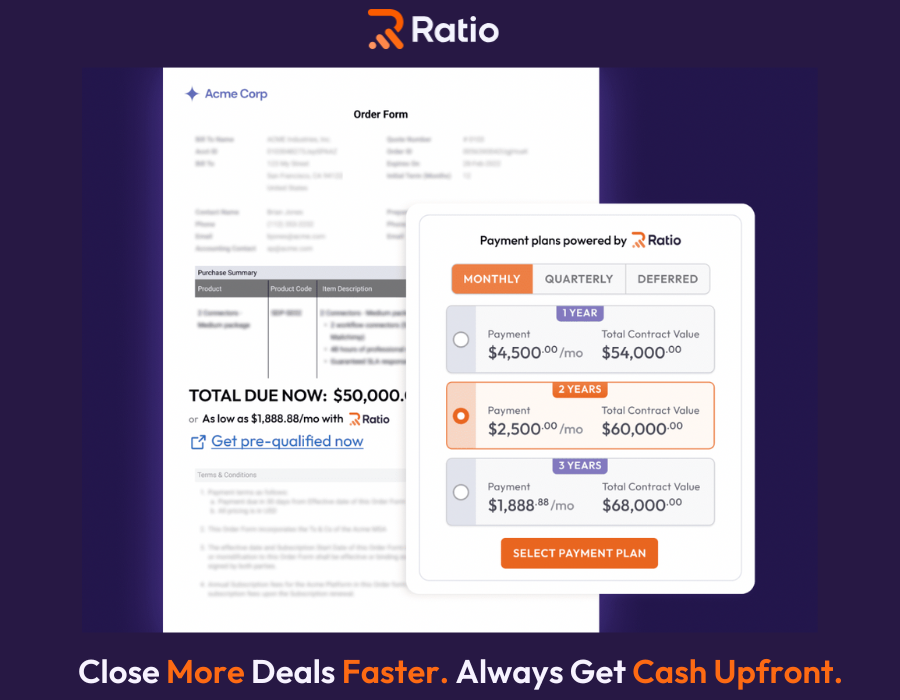
- 🧠 Instant Credit Underwriting - AI evaluates buyer intent, billing history, and CRM data in real time to approve financing instantly — embedded inside your sales motion. No forms, no friction.
- 🤖 Predictive Collections Automation - For financed deals, Ratio automates follow-ups based on real-time repayment signals — including buyer behavior, due dates, and credit risk. This reduces defaults, cuts manual collections, and keeps your cash flow protected.

- 💸 Flexible SaaS-Ready Billing - Supports recurring, usage-based, milestone, and hybrid billing models. Includes built-in tax engine, multi-entity compliance, and global invoicing support.
- 🔄 Automated Cash Application & Reconciliation - Payments are auto-matched to invoices using confidence scoring — speeding up reconciliation and shrinking unapplied cash buckets.
- 📊 DSO & Cash Flow Dashboards - Track repayment risk, cash velocity, and aging buckets in real time — all the forecasting insights without the AR backlog.
🔌Integration
- Native CRM & Billing Integrations - Works with Salesforce, HubSpot, Chargebee, and Maxio. Reps quote, offer terms, and close deals without switching tools.
🚀 Customer Success Story: HST (High-Speed Transactions SaaS Provider)
HST, a high-velocity B2B SaaS company, struggled with rigid annual prepay terms that led to:
- 💸 Discounts up to 55%
- ⌛ 6+ week sales cycles
- 🧾 10% of deals, turning into bad debt
- 📉 Manual AR processes, draining time and cash
HST adopted Ratio Boost, embedding BNPL into their quote-to-cash flow. Now:
- Reps offer flexible terms
- Finance gets full ACV upfront
- Ratio automates financing, collections, and disputes
Results:
- ⚡ 60% faster deal cycles
- 📈 +10% conversion rate
- 💰 No bad debt or aging invoices
- 🎯 Reduced discounting and Customer Acquisition Cost
- 😃 Happier customers, higher retention
By eliminating AR, HST turned a cash flow drag into a growth advantage—and is now rolling out Ratio Boost across every product line.
⚠️ Limitations
- Ratio doesn’t manage invoices that aren’t funded through Boost natively. If you rely heavily on manual collections or deferred workflows outside financing, you may still need light AR tracking tools.
- Boost works best when the sales team adopts it as the default flow, with full integration into your existing CRM. If your workflows aren’t digitized or you lack integration readiness, your sales team will need to use Ratio through its standalone portal.
- Ratio supports 80% of the use cases with its proposal software. If you have complex configurations (e.g., hundreds of SKUs), you might need to spend resources integrating Ratio into your current CPQ system.
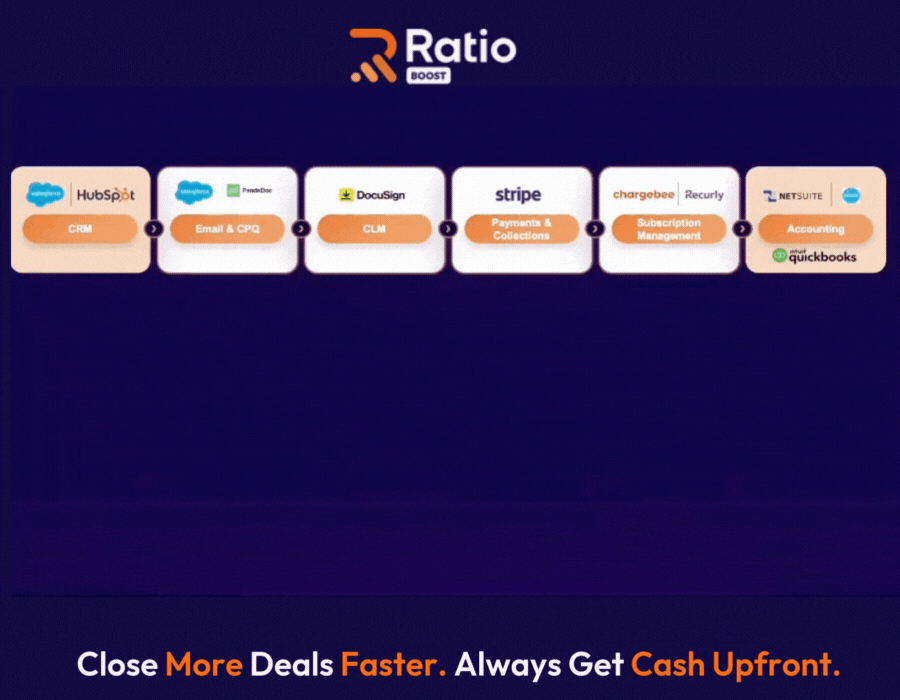
💰 Ratio Pricing
- Ratio Boost is free for SaaS sellers. You only pay a small fee to Ratio when a deal closes, and Ratio pays you upfront for that.
- You can even choose how to handle that fee: absorb it, pass it to the buyer, or split it.

🎯 Demo / Trial Availability
- You can book a personalized demo to see how Ratio Boost fits into your sales flow.
2) Upflow
Upflow is a next-generation Accounts Receivable (AR) management platform designed to help B2B companies accelerate cash collection, reduce DSO, and gain complete visibility into their receivables process. Evolving into a Financial Relationship Management solution, Upflow transforms AR from a back-office burden into a strategic growth driver.
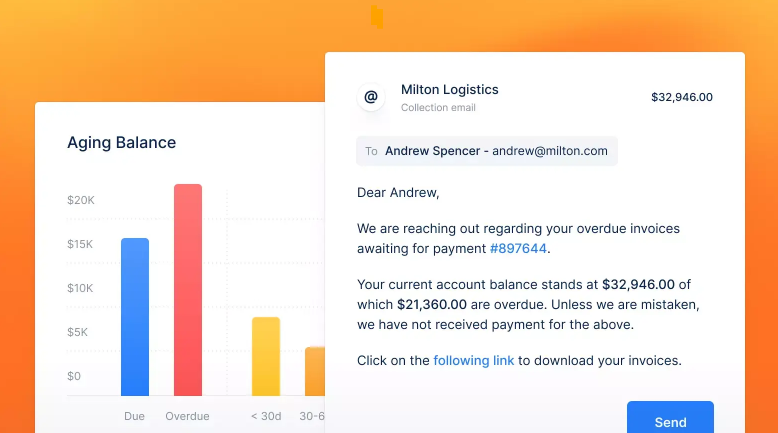
🔑 Upflow’s Core AR Capabilities
- Automated Collection Workflows - Trigger multi-channel reminders based on invoice status, aging, or customer behavior — reducing manual follow-ups and accelerating cash collection.
- Real-Time AR Analytics & Forecasting - Track DSO, aging buckets, and customer risk with live dashboards. Forecast future cash inflows using historical payment patterns and behavior scoring.
- Collaborative Receivables Management - Align finance, sales, and customer success with shared timelines, notes, and escalation workflows — all in one platform.
- Customer Payment Portal - Offer clients a seamless payment experience with branded portals, multiple payment options, and billing preferences.
- Custom Rules & Escalation Logic - Design collection sequences tailored to your customer segments — from gentle nudges to structured escalation workflows.
🔌Integration
Integrates natively with NetSuite, QuickBooks, Xero, Chargebee, Stripe, Salesforce, and supports custom workflows via open API.
🚀 Customer Success Story: Invicti
Invicti, a web app security leader, faced high DSO, overdue invoices, and manual, Excel-driven AR processes. After adopting Upflow, they streamlined collections, enabled autopay via Stripe, and gained real-time AR visibility.
Results:
- 📉 68% drop in 31+ day overdue invoices
- ⏱️ DSO reduced from 69 → 44 days in under 12 months
- 💳 17x growth in autopay adoption
⚠️Upflow - Limitations
- No native invoice generation
- No revenue recognition capabilities
- Relies on third-party processors for payments
- Limited for complex enterprise AR setups
- Customizations may require developer support.
💰 Upflow Pricing
- Upflow offers a range of plans, from free to paid tiers.
- For example, Grow and Scale plans typically range from $440 to $880/month, while Enterprise pricing is available upon request.
📌 Note: Pricing may vary—always confirm the latest rates directly with the vendor.
🎯 Demo / Trial Availability
- A free plan or trial is available on select tiers.
3) Maxio (formerly Chargify + SaaSOptics)
Maxio is a full FinOps + subscription billing suite for B2B SaaS: usage-based & recurring billing, AR/dunning, revenue recognition, and SaaS metrics—born from the Chargify + SaaSOptics merger.
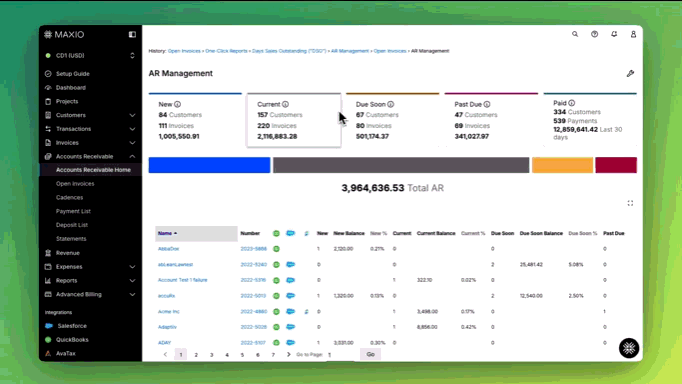
🔑 Maxio’s Core AR/Billing Capabilities
- Usage-based billing with automated dunning – Supports complex pricing models and reduces involuntary churn with built-in dunning.
- Finance-grade revenue recognition & analytics – ASC 606/IFRS-compliant reporting with accurate SaaS KPI tracking.
- AR aging & cohort reporting – Tracks invoice aging, overdue balances, and payment trends by account or cohort.
- Collections dashboard & task automation – Centralized view of invoices, payments, and tasks with automated follow-ups.
- Multi-entity & multi-currency support – Manages billing across subsidiaries, currencies, and tax jurisdictions for global SaaS.
- Invoice templates & custom schedules – Flexible invoicing for recurring, milestone-based, or consolidated contracts.
- Quote-to-cash automation – Streamlined quoting, invoicing, collections, and revenue recognition workflows.
- Customer payment portal – Gives customers access to invoices, payments, and AutoPay options in one place.
🔌Integration
- Connects with NetSuite, QuickBooks, Sage Intacct, Stripe, Salesforce, Avalara, and other tools across billing, payments, CRM, and tax.
🚀 Customer Success Story: Extensiv
Extensiv (formerly 3PL Central), a leading omni-channel fulfillment provider, adopted Maxio in 2019 to scale with growth and acquisitions—streamlining billing, automating renewals, and simplifying collections with self-service e-invoices.
Results:
- 📈 250% ARR growth since implementation
- 🔄 Billing standardized across three acquisitions
- ⚡ Month-end close within five days
⚠️ Maxio - Limitations
- Occasional sync issues with accounting platforms
- Complex setup; not ideal for lean finance teams
- Limited flexibility in reporting UI
- Revenue recognition requires implementation expertise
- Pricing scales quickly with usage and features
💰 Maxio Pricing
- Maxio’s published entry-tier plan, Grow, starts at $599/month for up to $100K in monthly billings.
📌 Note: Higher-tier and enterprise pricing are based on billing volume and required feature sets—custom quotes are available upon request.
🎯 Demo / Trial Availability
- A demo is available. Some listings also mention a free or trial tier, but you’ll need to confirm this with the sales team.
4) Invoiced
Invoiced is an AR automation platform that streamlines invoicing, collections/dunning, cash application, forecasting, and offers a self-serve customer portal (including AutoPay and subscription management).
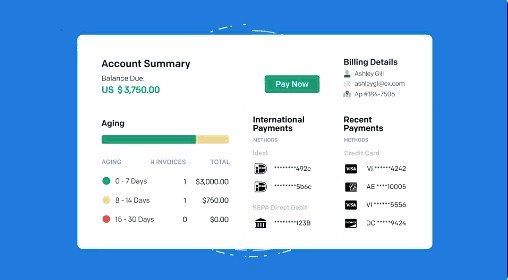
🔑 Invoiced’s Core AR Capabilities
- Customer self-service portal – Lets customers view invoices, enroll in AutoPay, and manage subscriptions independently.
- End-to-end AR automation – Automates billing, collections, reporting, and reconciliation in one flow.
- Automated dunning & reminders – Multi-channel follow-ups by invoice status, aging, or customer segment.
- Cash application & payment matching – Auto-matches payments to invoices, including partials and overpayments.
- Recurring & subscription billing – Handles fixed, usage-based, or hybrid recurring billing models.
- Payment plans & installments – Enables flexible schedules, deferments, or installment options.
- Advanced reporting & forecasting – Provides real-time dashboards with AR metrics and payment insights.
- Audit trails & activity logs – Tracks every AR action for compliance and transparency.
- Multi-entity support – Manages receivables across multiple business units in a single platform.
🔌Integration
Integrates with NetSuite, QuickBooks, Xero, Oracle NetSuite, Salesforce, Stripe, Square, PayPal, and supports REST API for custom workflows.
🚀 Customer Success Story: WebPT
WebPT, a fast-growing PT software provider, faced rising A/R demands and manual collection bottlenecks. With Invoiced, they automated collections, streamlined workflows, and gained real-time receivables visibility.
Results:
- 📉 11% reduction in receivables within 60 days
- ⏱️ 2-day DSO decrease in the first 30 days
⚠️ Invoiced - Limitations
- Limited revenue recognition; needs external tools for ASC 606/IFRS
- Some ERP integrations require middleware/custom setup
- Not ideal for high-volume enterprise use cases
- Limited UI customization and branding
- Quote-to-cash automation less extensive than full billing platforms
💰Invoiced Pricing
- Invoiced uses a quote-based pricing model tailored to each business’s size and needs.
📌 Note: Pricing may vary—always confirm the latest rates directly with the vendor.
🎯 Demo / Trial Availability
- A live demo is available — you can schedule it with Invoiced.
5) Billtrust
Billtrust is an AI-powered B2B AR platform spanning invoicing, payments, cash application, and collections. It’s named a Challenger in the 2024 Gartner Magic Quadrant for Integrated Invoice-to-Cash.
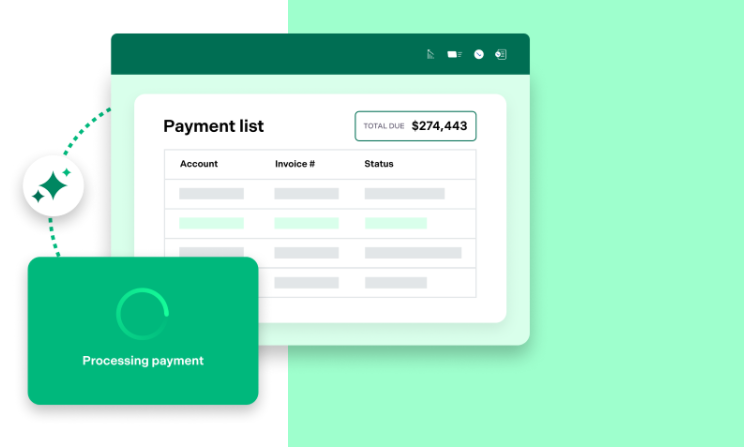
🔑 Bill Trust’s Core AR Capabilities
- End-to-end invoice-to-cash automation – Manages the full receivables cycle from invoice delivery to payment and cash application.
- Customer payment portals – Self-service portals where customers can view invoices, make payments, and manage preferences.
- Online & multi-channel invoicing – Delivers invoices via digital, email, print/mail, or AP portals with channel preference tracking.
- Cash application automation – Uses AI and OCR to match payments with remittance data and reduce manual reconciliation.
- Advanced collections management – Automates reminders and escalations with strategies based on customer risk, aging, and behavior.
- Dispute & deductions workflow – Tracks and resolves disputes or short payments with built-in workflows.
- Credit risk & scoring tools – Provides credit profiles, scoring, and decisioning tools to guide payment terms and reduce risk.
- B2B payment acceptance – Supports ACH, credit cards, virtual cards, wires, and checks on a PCI-compliant infrastructure.
- E-adoption services – Drives customer adoption of digital invoicing and payments through onboarding campaigns.
- Comprehensive audit trails & compliance – Ensures visibility across AR touchpoints to support audits and regulatory compliance.
🔌Integration
Integrates with 260+ AP portals and 40+ ERP, banking, and payment systems—including SAP, Oracle, NetSuite, Microsoft Dynamics, QuickBooks, and custom APIs—for end-to-end invoice-to-cash automation.
🚀 Customer Success Story: Global Tech Provider
A global information management firm mailing 760,000 invoices monthly streamlined operations with Billtrust—automating billing, enabling 24/7 payment portals, and shifting from paper to digital invoicing.
Results:
- 📈 Achieved 71% e-presentment rate (and still rising)
- 👥 Converted 33,000+ customers to digital invoicing in a year
- 📨 Now sending 1M+ bills/month, with 800,000 via email
⚠️ Bill Trust - Limitations
- Complex and time-consuming setup
- Some UI and usability complaints
- Limited customization without services
- Manual review needed for edge cases
- Expensive for mid-market or lower-volume users
💰 Bill Trust Pricing
- Billtrust follows a quote-based pricing model tailored to customer size, volume, and integration requirements.
📌 Note: Businesses should request a custom proposal from the vendor.
🎯 Demo / Trial Availability
- A demo is available — you can request it directly from Billtrust.
So far, it’s clear that each AR option comes with its own strengths. Some focus on automation, others on analytics, while Ratio Boost stands out by removing AR entirely. Together, they cover a wide range of SaaS needs—from SMBs chasing efficiency to fast-scaling teams prioritizing cash flow and growth.
📊 Now let’s put them head-to-head.
🏆Comparing SaaS Accounts Receivable Management Software Options Side by Side
The table below breaks down how each platform stacks up across invoicing, collections, payments, analytics, and financing—making it easier to see which fits your business best.
Each tool has its own strengths—be it automation, analytics, or scale—but only one actually fixes the real problem: delayed cash. That’s where Ratio Boost changes the AR game. Instead of chasing receivables, it removes them altogether with embedded financing, real-time underwriting, and flexible terms built right into your quote-to-cash flow.
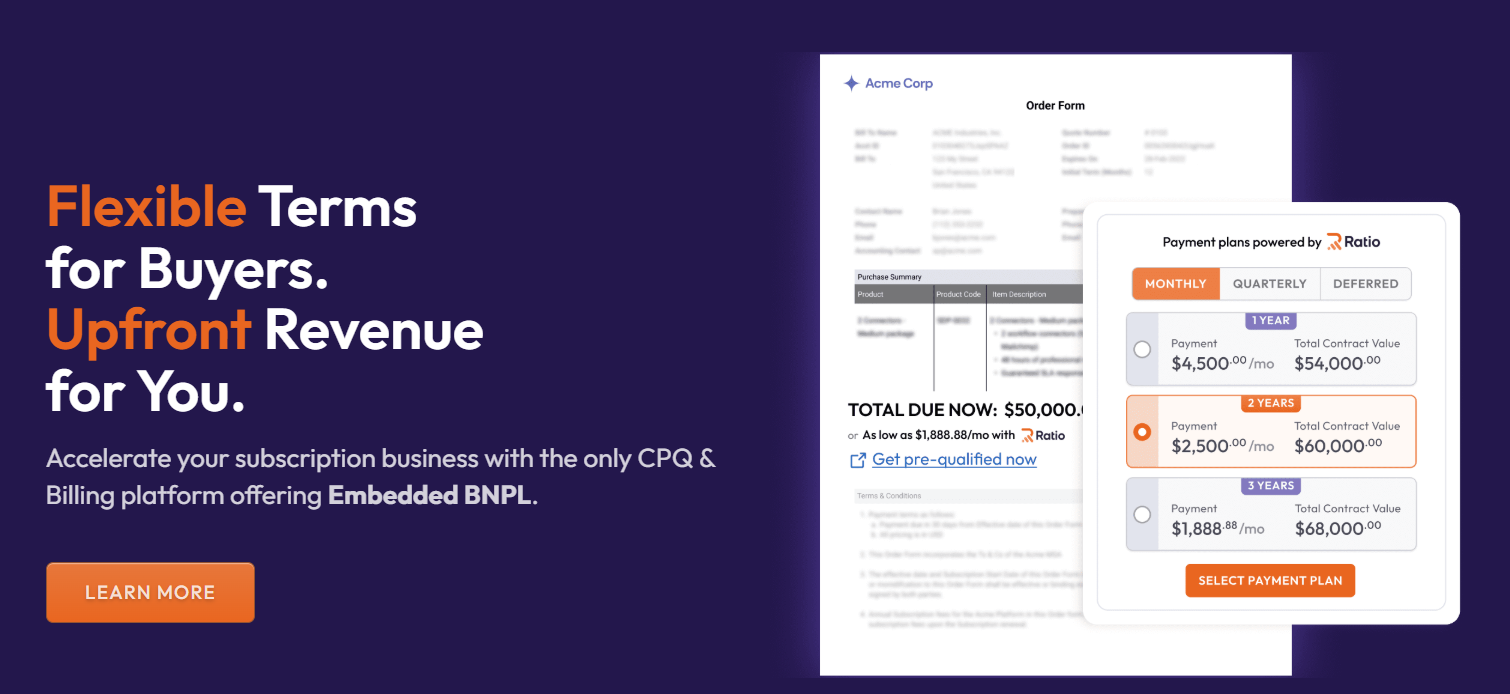
And there’s more. Let’s get into more reasons why Ratio is worth picking.
⚡ Why Ratio Boost Beats Other Accounts Receivable Management Software for Streamlining Cash Flow
Ratio Boost isn’t just another AR automation tool — it’s a complete rethink of how SaaS companies get paid.
- 💰 Backed by a $411M capital pool, Ratio pays you full contract value upfront — no delays, no debt, no dunning.
- 🧾 With the new Custom Payment Upgrade, reps can offer net-30, milestone-based, or deferred plans directly from the quote.
- 🤖 And coming soon: an AI-powered Collections Agent that predicts defaults and automates follow-ups before issues arise.
You’re not chasing payments — you’re closing deals, collecting instantly, and growing with cash already in hand.
Don’t just take our word for it….
Here’s what DearDoc’s founder shared from their own experience:
Now, if you, too, are ready to eliminate AR headaches and unlock growth, go ahead—
👉 Schedule a personalized demo today.
Disclaimer: This comparison is based on publicly available information and product capabilities as of 2025. Features, pricing, and functionality may vary depending on your use case, business model, and implementation. Readers should evaluate each billing solution based on their specific requirements and consult directly with vendors before making a final decision.
FAQs
1. How Do Accounts Receivable Management Platforms Impact Investor Confidence in SaaS Businesses?
Investors closely track metrics like free cash flow, DSO, and net retention rates. Strong AR management improves cash predictability, which signals financial discipline and reduces perceived risk—making SaaS companies more attractive for investment or acquisition.
2. What Are the 5 C’s of Accounts Receivable Management?
The 5 C’s are a traditional credit risk framework used to evaluate a customer’s ability to pay. While originally developed for lending, they’ve been adapted into accounts receivable (AR) management to assess customer creditworthiness before extending payment terms (e.g., Net-30, Net-60). Understanding these can help you reduce DSO, avoid bad debt, and tighten your AR controls.
3. What Role Does AR Automation Play in Customer Experience?
Automated reminders, self-service portals, and flexible payment options reduce friction for customers and give them more control. A smoother financial experience strengthens retention and decreases churn, since payment frustrations are a common cause of dissatisfaction in B2B SaaS.
4. How Do AR Tools Integrate with SaaS Revenue Operations (RevOps)?
By syncing AR data into CRM and billing systems, AR tools give sales, finance, and customer success teams a unified view of account health. This alignment allows proactive action—like flagging accounts at risk of churn or upsell—making AR management a core function of SaaS RevOps.


.png)




.png)


